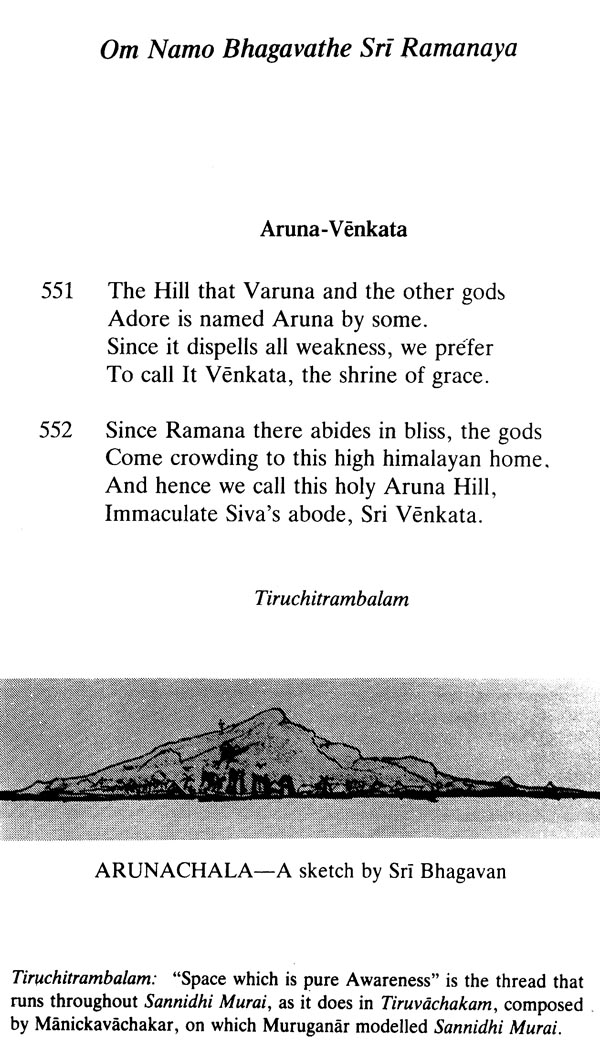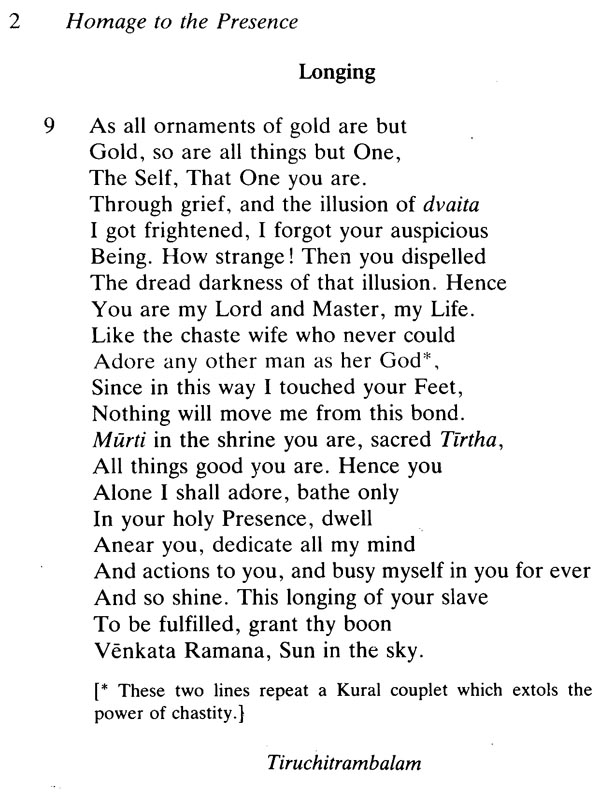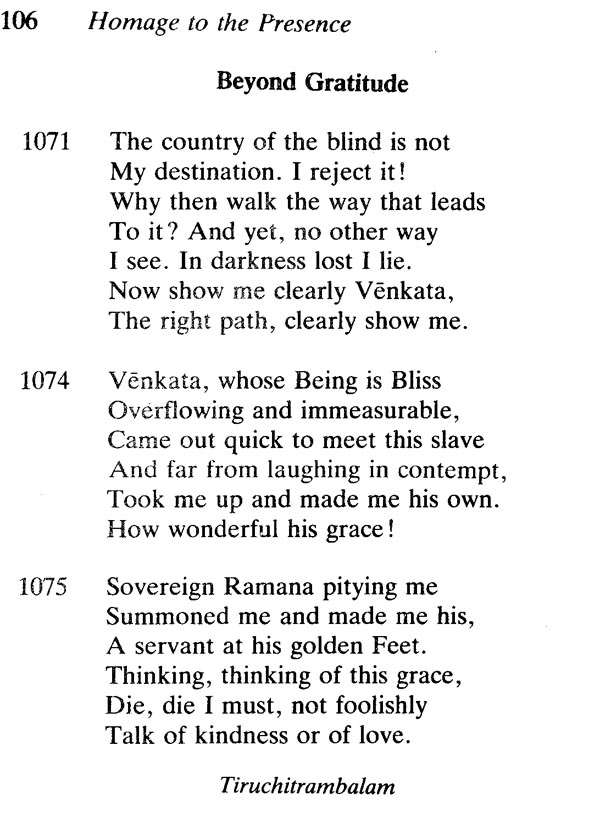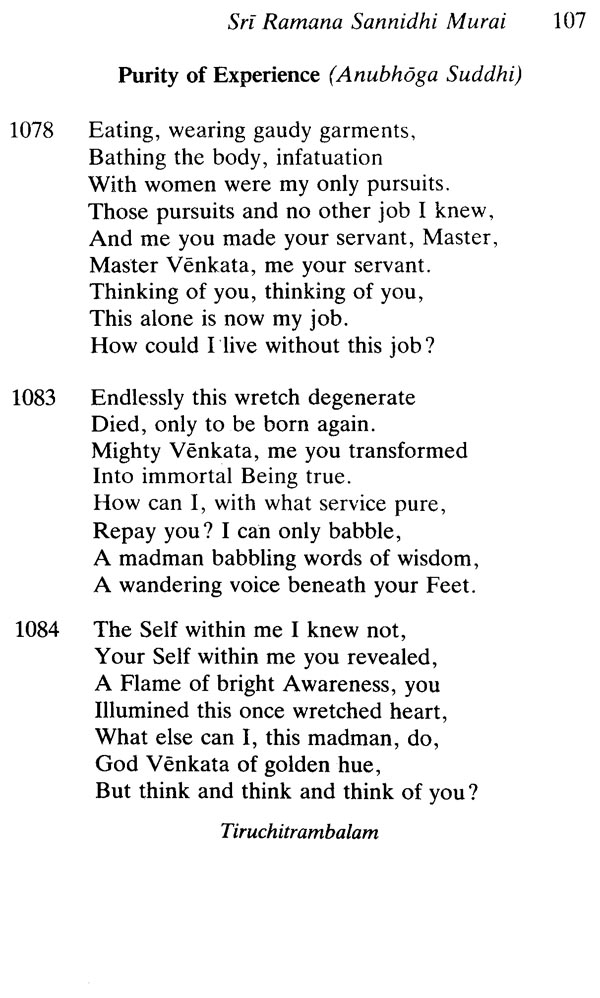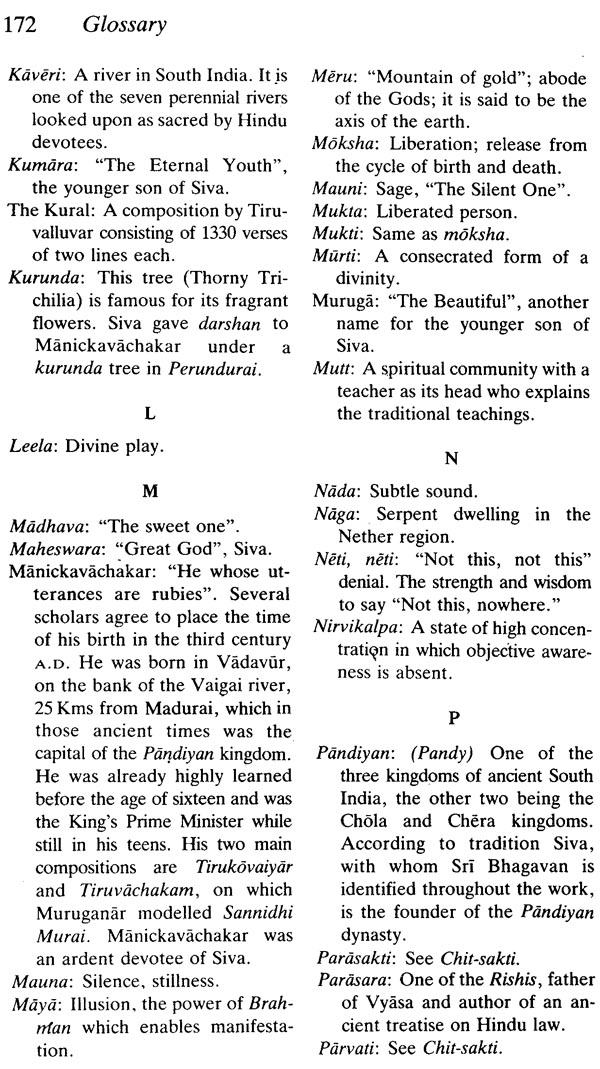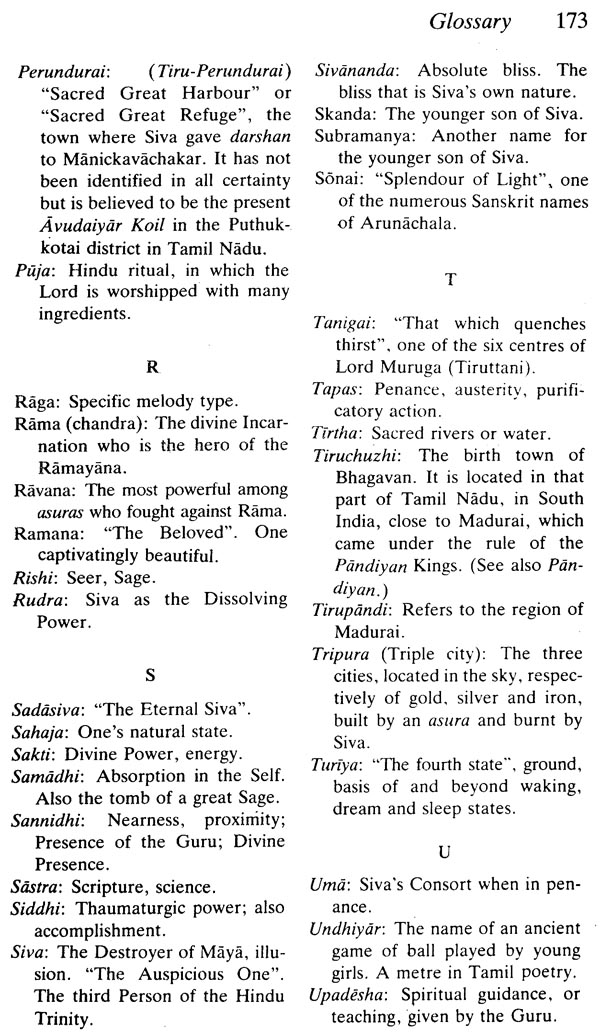
Homage To The Presence Of Sri Ramana (Sri Ramana Sannidhi Murai) (A Garland of Adoration) (An Old and Rare Book)
Book Specification
| Item Code: | IDI652 |
| Author: | Sri Muruganar And Translated From The Tamil By Prof. K. Swaminathan |
| Publisher: | Sri Ramanasramam, Tamil Nadu |
| Edition: | 1994 |
| Pages: | 190 (Black & White Illus: 9) |
| Cover: | Paperback |
| Other Details | 8.5"X 5.4 |
| Weight | 300 gm |
Book Description
The foremost duty to the Guru of a fully dedicated aspirant is to live the Master's teachings in such a way that his own flowering benefits not only himself but radiates its fragrance for all to imbibe. As mystic, poet and devotee par excellence, Muruganar fulfilled this duty to perfection. His life was an example in perfect devotion, and his poetical outpourings, composed in the most exquisite classical Tamil, display the merging of bhakti into Jnana, leaving a legacy for all time.
Muruganar's two main works, Guru Vachaka Kovai (The Garland of Guru's Sayings) and Sri Ramana Sannidhi Murai (Homage to the Presence), stand alone as pillars to Jnana and bhakti, Jnana mata. The Garland of Guru's Sayings is a treatise, a Sastra, of 1254 verses expounding the highest Jnana as taught by Sri Bhagavan. In Homage to the Presence, his stotra, or hymn of adoration, Muruganar expresses his well of devotion to the Guru in 1851 verses of soul-stirring poetry.
Both works were translated into English by Professor K. Swaminathan and serialized in The Mountain Path from its inaugural issue onward. The Garland of Guru's Sayings was re-edited and published as a book in 1990, as a centenary tribute to Muruganar. It was immediately acclaimed "a treatise which provides the most precise, systematic and authoritative exposition of Bhagavan's teaching".
We are now happy to be able to offer a selection of 473 verses of Homage to the Presence. As with The Garland of Guru's Sayings, all credit for the newly edited verses goes to Professor K. Swaminathan for his unfailing perseverence in rendering Muruganar's poetry into English verse. We are confident that the rasa, or essence of unswerving and irreproachable devotion embodied in these verses will be received as amrita, nectar supreme, in instilling in the reader unfailing inspiration in the conduct of his Sadhana.
In collecting the scattered verses we owe a grateful debt of gratitude to Smt. Sulochana Natarajan. For finalizing the English translation we are grateful to Smt. Mahalakshmi Suryanandam and her husband, Sri P. R. Suryanandam. Special acknowledgement also goes out to a devotee whose monumental and indispensable efforts in coordinating this work were a labour of love borne of a boundless debt of gratitude to Muruganar.
Paying obeisance to Muruganar's exemplary Ramana seva, we offer this stotra mala, this garland of adoration, Homage to the Presence at the Holy Feet of Sri Bhagavan.
In speaking about Muruganar one should say something of Sri Ramana Maharshi himself as the central figure in the Tamil spiritual tradition and on the place of poetry in the Indian scheme of things. Sri Ramana is as clearly the fruition of Tamil culture with its rigorous intellectual precision and down-to-earth realism as Sri Ramakrishna is, of Bengali culture with its emotional wealth. The Kural distinguishes sharply between two modes of human experiences: tiru, opulence and telidal, clarity. Vishnu, Alankarapriya (Lover of decoration), stands for a wide spectrum-of prosperity, the power of dharma. Siva, Abhishekapriya (Lover of ablution), stands for clarity, the bright light of pure Awareness, the peace of moksha. Vishnu rejoices in the multitudinous variety and complex inter-relationship of the numbers two to infinity while Siva's concern is with zero (total absence) and one (total presence). There can be Krishna prema (intense love) and Rama seva (dedicated service) but Siva admits only of Sivamiidal (becoming Siva), the sukhi (enjoyer) expiring in sukhitva (enjoyment). But in Tamil land Siva has also acquired flesh and blood, form and feature.
It was in Tamil land that Siva and His two sons came down to earth and sported with mortals and gave rise to situations charged with abiding charm and profound signific- ance, thus releasing a perennial stream of poetry which custom cannot stale and cleverness pollute. While the Maharshi with his mathematical intelligence makes little use of this traditional wealth of imagery and style, Muruganar rejoices rapturously in it and, in the process, established for himself a secure and eminent place in Tamil devotional literature comparable to that of Manickavachakar.
The vision of death followed by "spontaneous illumina- tion" so swift, so complete and so permanent that transformed the schoolboy into a sage has astonished foreign observers; but pious Hindus accept this great event as yet another, if also contemporary, manifestation of Siva's grace. The con- substantiality and interplay of God and Man form the very foundation of South India Saivism.
Well pleased to intermingle
With his seer-servants, Siva enters
In among the saintly throng
Of those whose faith is strong,
Conceals His form, assumes another,
And with love enraptured, sports.
The Garland of Guru's Sayings
The West, which knows nothing of Siva, conceives of Time as something flowing from the past into the present. For us Siva is eternity, the timeless, the pure, formless awareness which is the sole reality, the whole of the unknown future forever freshly moving into time. Confronting this current stands Muruga with his twelve eyes and twelve arms. Swimming upstream we have to live in the living present, the meeting point of two eternities. Only very foolish, old people live in the dead past. Siva, pure, timeless awareness, operates in and through Muruga, the human god divine, the glimpse of moksha here and now, known in every heroic moment to lovers, poets and warriors. Muruga might have been in origin a tribal god; for the poet he is the perennial play of the light eternal on the swift-moving waters of prakriti. In the Indian tradition the two ultimate values are Truth, with its clarity, and Beauty, with its manifold power to please and guide us human beings. Vishnu and Siva, Beauty and Truth, are the empirical and transcendental aspects of the one Reality. Because other nations have lost the relish for eternity and the meanings and right management of their mythology, we need not impoverish ourselves by starving our aesthetic sensibilities and denying or suppressing the voice of poetry in the conversation of mankind. Mythology provides a broad, safe bridge for two-way traffic between the real and the actual. Properly handled by poets and widely enjoyed by childlike minds, it can work wonders. It is the surest means of communicating to common people the most profound truths, of transforming the consciousness of whole communities.
Whatever is vital and worth preserving in the past, the bonds of love and mutual obligation that bind all living things together, the dharma which is power, the compulsion of beauty, the dynamism of goodness and morality in conduct, the joy of awareness, are preserved out of love, not out of fear. In The Garland the philosophy is paramount and little is lost or misleading in the English translation. But Sannidhi Murai is pure lyric. Here the music (rhyme, alliteration, assonance) and fancy are dominant and we should not fall into the trap of making Muruganar appear 'cheap' when translating into English.
The themes and modes, the style and imagery adopted in Sannidhi Murai, the hymns of praise, seem on the surface to be borrowed from the great medieval singers. But there is nothing merely repetitive or imitative in Muruganar, whose words apply with perfect aptness to his hero, an actual person, historical and contemporary, because this presence too radiated love, knowledge and a shared beatitude. The marriage of mythology and history is made explicit in many of Muruganar's poems, most of all in the magni- ficent Undhiyar where Maharshi is identified with Rama, Krishna, Skanda (Muruga) and Siva and, in this the latest role, made to utter the quintessence of Advaita in Upadesha Undhiyiir (Upadesha Saram). The message delivered by Siva-Ramana, the eternal Self, is then asserted by the poet to be identical with the teachings of Buddha and Jesus.' In practising the Presence of Bhagavan under the terms of Muruganar's images and rhythms, one enters into intensely felt relations with the Guru, who figures in the various roles of Siva or Subramanya, as father, mother or lover, as master, king or commander, as beggar or betrayer.
It is given to few to appreciate the architectonics, the prosodic and metaphysical suggestions in the songs of this most scholarly poet, and it is given to fewer still to recognise in them the modulated echoes of the Master's vibrant silence. With Muruganar one finds oneself taking part in a strenuous game where transcendental experience is created and caught in words, coloured or common as he chooses. The universal teacher who teaches through silence is made to manifest in a thousand sounds and sweet airs, each uniquely appropriate to a role and a mood. Thrice blessed is the ear which is trained to hear the secret that only Muruganar can utter. For in his garden of delight one sports with God in a riot of rhymes and eats for ever the ever-fresh fruit of knowledge that home is heaven and heaven is home. 2 It was through his father-in-law, Dandapani Swami, who gave him the copies of Arunachala Sthuti Panchakam (Five Hymns to Arunachala) and Nan Yar? (Who am I?) that Muruganar came to Sri Bhagavan. Devout Siva bhakta that he was, he went straight to Arunachaleshwara Temple after reaching Tiruvannamalai, where, after bowing down to the Lord, he wanted to proceed to the Ashram. It was in September 1923. While about to start he felt he should not go empty-handed when going to meet a Sage. He sat within the Temple itself and composed a hymn of eleven verses in praise of Sri Bhagavan. They were inspired ones in the pattern of Saint Manickavachakar's Tiruvachakam. What was to happen later the poet unwittingly mentioned at the very outset, for he was acclaimed even in the days of Sri Bhagavan as Manickavachakar and Bhagavan Ramana as Siva!
Those verses, Desika Patikam (Decad on Ramana the Teacher) show how Sri Muruganar was totally taken by Sri Bhagavan even before he saw him.
With this hymn he had just composed, he reached the Ashram. He did not know how to meet the Sage, not knowing what regulations, if any, observe as is customary in mutts and ashrams. In those days there was only a thatched shed in which SrI Bhagavan and others lived.
Discerning the predicament of this potential devotee, as it were, Sri Bhagavan himself came out of the cottage when Sri Muruganar reached its entrance. SrI Bhagavan looked straight at him. A miracle took place! The look of the Master on that day kindled the fire of poesy which glowed in him ever after. "What?" Sri Bhagavan asked; Sri Muruganar was totally absorbed in him and the vichara brought him back to life. He started singing (in the particular specified tune) the verses composed by him at the temple.
Guru Ramana, Siva, as once you left
Mount Kailas and the company of Gods
And came to cool Perundurai to drink in
The sparkling words of Vachakar,
Now again you have come to fair Aruna Town
Wishing to harken to this fellow puerile words
Tears welled up in his eyes and he could not proceed. The tune of his reading was obstructed. "Can't you read? Give it to me. I shall myself read it," said Bhagavan (Muruganar narrated this to me with tears and added that though he had specified tunes to each of his thousands of verses, that was the only occasion and the last one too when he read out to him his poems attuned to their ragas: never afterwards could he sing! ) He also added that from that very day he was made anon-entity, having lost his separate individuality. As a devotee put it so aptly, he then became the "shadow of Bhagavan".
In Sri Muruganar we see a glowing example of a tradi- tional Guru-sishya (Master-disciple) relationship. He was great not because he wrote thousands of verses on SrI Bhagavan but because he lived what he learnt from his Master. Not only was he living a life of complete self- surrender to ths Master but he also urged those who went to him for guidance to do so. Never did he claim anything for himself nor did he look upon anyone as his disciple. He always directed .those who approached him for help or guidance to go to Bhagavan, even after the Mahanirvana of Sri Bhagavan, saying that Bhagavan Ramana was. the sole Master for all. His devotion to the Master was supreme and his understanding of the Master's teaching was unparalled. Thus he was ever one with his Guru !
| Aruna-Venkata | 1 |
| Longing | 2 |
| Sacred Verses of Praise | 3 |
| Singing of His Nature | 5 |
| Speaking of His Beauty | 6 |
| Speaking of Refuge | 7 |
| Destruction of Karma | 8 |
| Proper Placing | 9 |
| Tirumantiram | 12 |
| Decad of Prayer | 13 |
| Yearning When | 14 |
| O God Supreme | 15 |
| Decad on Ramana the Teacher (Desika Patikam) | 17 |
| Ramana Deva | 17 |
| Decad of Thought | 20 |
| Decad of Grace | 22 |
| Decad of No More Life | 25 |
| Decad of Prayer for Encouragement | 26 |
| Decad of Holding Firm | 27 |
| Living Glory of Aruna | 28 |
| True Life | 29 |
| Sacred Stanzas on the Sacred Feet | 30 |
| Decad of Refuge | 31 |
| Decad of Union | 32 |
| Decad of Enslavement | 34 |
| Ramana Gitam | 35 |
| Decad of Vision | 37 |
| Decad of Possession | 38 |
| The Warrior | 39 |
| Decad of the Head | 40 |
| Decad of the Miracle | 41 |
| Decad of Wonder | 42 |
| Seeing the sacred Form | 43 |
| Seeing the Sacred Feet | 44 |
| Decad of Seeing the World | 45 |
| Decad of Tiruchuzhi | 46 |
| Decad of Worship | 48 |
| Decad of Melting | 49 |
| Decad of Supplication to Ramana | 51 |
| Decad of Petition | 53 |
| Decad of Appeal for Compassion | 54 |
| Not Being Dead | 55 |
| Decad of No Otherness | 56 |
| Ramana as Muruga | 57 |
| Decad of No Repaying | 58 |
| Decad of Knowing Nothing Else | 60 |
| Decad of No Other Shrine | 62 |
| Decad of Sovereignty | 63 |
| Decad of No Other Thought | 64 |
| Can I Forget You? | 65 |
| Decad of Dread | 66 |
| The Sacred Pledge | 67 |
| Decad of Tirupandy | 68 |
| Awakening to Life | 69 |
| Word of Assurance | 70 |
| Call for the Army | 71 |
| The Glory of the Presence (Sannidhi) | 72 |
| Decad of the Journey | 73 |
| The Love-Lorn Maiden Speaks | 75 |
| Mother's Grievances | 76 |
| Mother's Lamentations | 77 |
| Mother's Pleading | 78 |
| Condemnatory | 79 |
| Foster-Mother's Plea | 80 |
| Ramana, Master of Maya | 81 |
| The Heroine's Entreaties | 82 |
| To the Bee-Messengers | 83 |
| The Bee-Messengers's Reply | 84 |
| Garland of Bliss | 85 |
| Grief | 86 |
| Lord Ramana of Aruna | 87 |
| Glory of Ramana | 88 |
| Ramana Leela | 91 |
| Decad of Sonai | 93 |
| Steadfastness in Service | 94 |
| Anubhuti (Experience) | 97 |
| Paranalladu (Nothing but the Supreme) | 99 |
| Sacred Decad of Gifts from Sonai | 100 |
| True Experiencing | 101 |
| Appeal to the Heart | 102 |
| Ramana the Magician | 103 |
| Inner Purity | 105 |
| Beyond Gratitude | 106 |
| Purity of Experience (Anubhoga Suddhi) | 107 |
| An appeal for Compassion | 108 |
| Ecstatic Joy | 110 |
| Bliss Transcendent | 111 |
| Song Divine | 112 |
| One and Yet Not One | 113 |
| Indispensability | 114 |
| Having Reached His Feet | 115 |
| The World's Wealth | 116 |
| Final Freedom | 117 |
| The Glory of His Grace | 118 |
| You Are All | 119 |
| Difference, Non-Difference | 120 |
| Unfathomable | 121 |
| Longing for Freedom | 122 |
| Stillness | 123 |
| True Worship | 124 |
| True Awareness | 125 |
| True Being | 126 |
| Ancient Wisdom | 127 |
| Sacred Venbas | 128 |
| Tiru Undhiyar | 130 |
| Perfection of the Form | 131 |
| Power of Grace | 132 |
| Noble Servitude | 133 |
| Waking up Song (Tirupalli Ezhuchi) | 134 |
| Maiden's Bathing Songs (Tiruvembavai) | 136 |
| Thiru Chazhal-A Game | 147 |
| Clap Hands and Sing and Dance | 148 |
| The Shoulder Game (Thiruthonokkam) | 149 |
| The Eye-Meeting Game | 150 |
| The Game of plucking Flowers | 151 |
| Golden Fragrant Powder | 152 |
| The Sacred Golden Swing | 154 |
| To the Kokila (Cuckoo) | 155 |
| To the King Butterfly | 156 |
| Praises | 157 |
| COMPOSITIONS BY MURUGANAR | |
| The Shock | 158 |
| Silent Master's Sovereign Presence | 159 |
| Glance of Grace | 161 |
| The Sustainer | 162 |
| God of Gods | 163 |
| The Light Supreme | 164 |
| The Living Heart | 165 |
| Journey Homeward to the Self | 166 |
| Continued Presence | 167 |
| The Blind Seer | 167 |
| Ramana | 168 |
| Appendix | 169 |
| Glossary | 170 |
